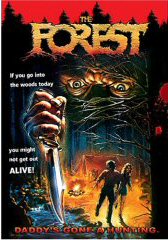
90 minutes of non-stop suspense, panic-riddled atmosphere, and physical carnage, The Forest is a double threat of the supernatural and the all-too-real, merging specters and a deliciously depraved murderer into a surprisingly successful stew of physical and ethereal terrors. It's also a prime example of the absurd. Explorations of humankind's basest, most animalistic tendencies -- sex and death -- the slasher film has long been revered by fans (and reviled by critics) for its organic celebration of debauchery. Small wonder that this particularly lurid, earthy sub-genre should find its greatest moments of violence and revelation unfolding in forests, themselves a last bastion for, and symbol of, man's savagery. The struggle for survival is a paramount theme in this sadly neglected cult treasure, contributing to the 80's slasher boom a story as moody and drenched in atmosphere as it is joyfully exploitative. Code Red continues to unearth surprisingly obscure films for the appreciation of genre fans, doing its part to keep the exploitative spirit of psychological horror alive by building a unique catalogue of titles that wouldn't even be considered in today's politically sensitive age.
In a story as simple as it is suspenseful, using as its dark heart a premise that keeps the narrative focused at the very same time that it heightens suspenseful moments, The Forest features the lovely Sharon and Teddy, two campers out for a bit of fun in the woods. Wrestling with the internal wilderness of their emotions even as they find their way across the deliciously photographed wilderness, they discover that they have more to fear than poison when they are attacked by a strangely sympathetic cannibalistic madman. "Daddy's gone hunting" reads the tag-line for this picture, suggesting the delightfully demented nature of the story and its dark sense of wonder . . . and cruelty. Struggling for survival in the shadow-drenched, 'watchful' forest of the California wilderness, Teddy, Sharon, and their boyfriends Steve and Charlie find themselves in the middle of a tragedy that began years earlier, when the killer, John, murdered his unfaithful wife and her lover. Discovering that John's kids committed suicide soon after, Sharon teams up with the bereaved spirits to stop their blood-crazy father.
The Forest is a good example of how comedic and entertaining a 'killer in the woods' picture can be. If at times over simplistic and pedestrian in delivery, the film manages to be suspenseful in its structure, allowing us to empathize with its victims at the same time that we thrill to moments of savage slaughter and mystery -- the later represented by the ghosts of the children who lurk the shadow-haunted woodland. The symbolic importance (and shared primal intimacy) of the Slasher genre -- and the forests within which so many of these stories unfold -- is emphasized by the director's insistence that the woods are treated like any other character. Psychologically speaking, the forest of this picture, and the woods in a majority of these movies, represent the freedom and break down of taboos in the human soul. Chaos, primal savagery, and unrestrained animal instinct are celebrated as characters, allowed room to develop in a story that resonates with the rusticity of a traditional folktale.
Another winner in terms of visual clarity, The Forest is featured in anamorphic widescreen (1:85) without the speckling, grain, or line damage one would associate with a film this rare, and of this age. The picture is clear, emphasizing Don Jones' directorial savvy with color, which are bright and lucid, adding a phantom-like quality to the brutal carnage. Audio is clean and professional. Extras are instructive and engaging, shedding light on particulars of this macabre treasure. Most insightful is the Commentary with Director Don Jones and actor Gary Kent, both of which prove themselves knowledgeable on the craft in general and most enthusiastic about the film, sharing jokes and insights (good and bad) about the filming experience. The Promo Trailer is pure exploitative fun, clearly stating the level of simplistic thrills to come, and the Photo Gallery weighs in with shots of the actors wearing make-up, waiting for scenes, technicians setting up shots, etc. Additional Trailers of upcoming Code Red titles are marvellous little explosions of graphic nastiness and sexual depravity -- reason for fans of rare Grindhouse and Drive-In Fare to rejoice. Spots for such neglected (surprisingly taboo-breaking) treats as School Girls in Chains, Devil Times Five, Sweet Sixteen, and Secrets of Sweet Sixteen are featured along trailers for Don't Go In The Woods Alone, Journey to the Center of the Earth, and Beyond the Door. The strongest supplement isn't even listed on the box cover. Completed at the last moment, rare interviews with the cast and crew explore the film and its creative process with bluntness and humor, and are an indispensable addition to the package. Don Jones (director), Stuart Asbjornsen (cinematographer), Gary Kent (actor), and are interspersed with film footage as we learn about the inspiration for the story, Don's struggle to film the production, the betrayals he experienced seeking distributorship, and, more pleasantly, details from the shoot itself, including games in the woods, memories of the cast, etc.
Review by William P. Simmons
| Released by Code Red |
| Region 1 - NTSC |
| Not Rated |
| Extras : see main review |